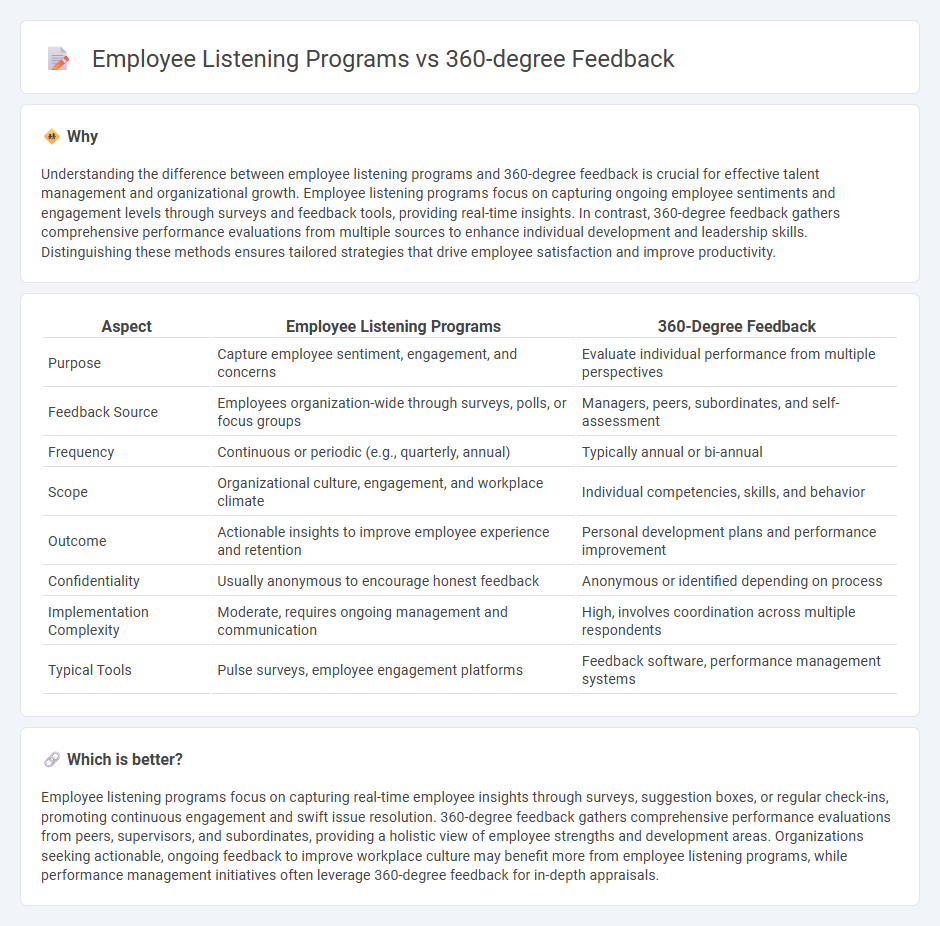
Employee listening programs focus on gathering ongoing feedback directly from employees to improve workplace culture and engagement, whereas 360-degree feedback involves collecting performance evaluations from an employee's supervisors, peers, and subordinates for comprehensive development. These approaches leverage data-driven insights to enhance communication, identify training needs, and foster employee growth. Discover how integrating both strategies can transform your HR practices for better organizational outcomes.
Why it is important
Understanding the difference between employee listening programs and 360-degree feedback is crucial for effective talent management and organizational growth. Employee listening programs focus on capturing ongoing employee sentiments and engagement levels through surveys and feedback tools, providing real-time insights. In contrast, 360-degree feedback gathers comprehensive performance evaluations from multiple sources to enhance individual development and leadership skills. Distinguishing these methods ensures tailored strategies that drive employee satisfaction and improve productivity.
Comparison Table
| Aspect | Employee Listening Programs | 360-Degree Feedback |
|---|---|---|
| Purpose | Capture employee sentiment, engagement, and concerns | Evaluate individual performance from multiple perspectives |
| Feedback Source | Employees organization-wide through surveys, polls, or focus groups | Managers, peers, subordinates, and self-assessment |
| Frequency | Continuous or periodic (e.g., quarterly, annual) | Typically annual or bi-annual |
| Scope | Organizational culture, engagement, and workplace climate | Individual competencies, skills, and behavior |
| Outcome | Actionable insights to improve employee experience and retention | Personal development plans and performance improvement |
| Confidentiality | Usually anonymous to encourage honest feedback | Anonymous or identified depending on process |
| Implementation Complexity | Moderate, requires ongoing management and communication | High, involves coordination across multiple respondents |
| Typical Tools | Pulse surveys, employee engagement platforms | Feedback software, performance management systems |
Which is better?
Employee listening programs focus on capturing real-time employee insights through surveys, suggestion boxes, or regular check-ins, promoting continuous engagement and swift issue resolution. 360-degree feedback gathers comprehensive performance evaluations from peers, supervisors, and subordinates, providing a holistic view of employee strengths and development areas. Organizations seeking actionable, ongoing feedback to improve workplace culture may benefit more from employee listening programs, while performance management initiatives often leverage 360-degree feedback for in-depth appraisals.
Connection
Employee listening programs and 360-degree feedback are interconnected tools in human resources that enhance organizational communication and performance. Employee listening programs gather continuous input from staff, creating a culture of openness, while 360-degree feedback provides comprehensive evaluations from peers, managers, and subordinates, offering diverse perspectives. Together, they promote employee engagement, identify development opportunities, and improve leadership effectiveness.
Key Terms
Multi-rater Assessment
360-degree feedback is a multi-rater assessment tool that gathers performance insights from an employee's supervisors, peers, subordinates, and sometimes clients, providing a comprehensive view of strengths and areas for improvement. Employee listening programs, while also collecting feedback, emphasize continuous engagement, often using pulse surveys and real-time data to gauge employee sentiment and organizational culture. Explore how integrating multi-rater assessments into employee listening frameworks can enhance feedback accuracy and drive impactful development strategies.
Continuous Feedback
360-degree feedback gathers performance insights from multiple sources including peers, managers, and subordinates, creating a holistic view of employee competencies and development areas. Employee listening programs emphasize ongoing, real-time feedback through surveys, polls, and open communication channels to address issues promptly and align with organizational goals. Explore how combining continuous feedback strategies enhances employee engagement and drives performance improvements.
Employee Voice
360-degree feedback collects performance insights from multiple sources, including peers, managers, and subordinates, offering a comprehensive view of an employee's strengths and areas for improvement. Employee listening programs prioritize real-time, ongoing feedback from employees to gauge engagement, morale, and organizational culture, fostering a consistent employee voice. Explore how integrating both methods enhances organizational communication and employee development.
Source and External Links
10 Examples of How to Give 360deg Feedback to Your Boss in 2025 - 360deg feedback is a review process gathering different perspectives on employee performance, boosting engagement, self-awareness, and improving work relationships through anonymous, honest input from multiple sources.
What is 360 Degree Feedback? - CustomInsight - 360 Degree Feedback is a confidential assessment system where employees receive anonymous evaluations from managers, peers, and direct reports to provide a holistic view of performance and promote development and accountability.
360 Degree Feedback: Process, Examples & Template - Personio - 360 degree feedback collects input from managers, peers, reports, self, and sometimes external stakeholders to deliver a comprehensive, multi-rater evaluation that enhances employee performance management.
 dowidth.com
dowidth.com